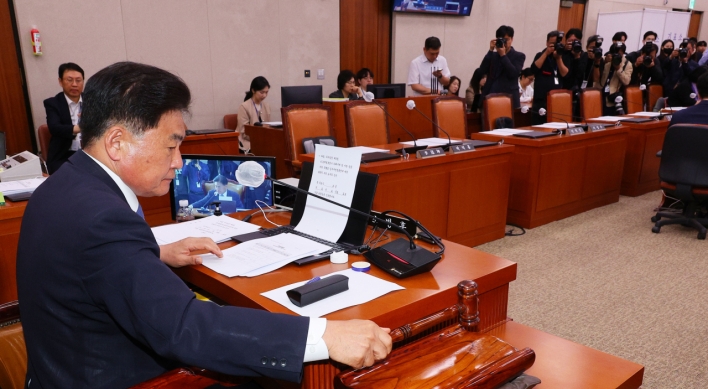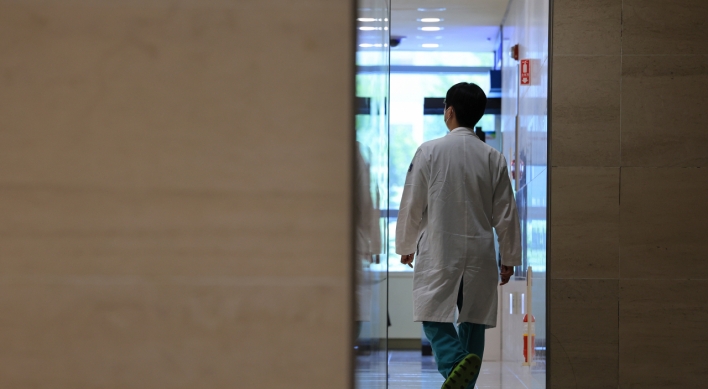[Lee Kyong-hee] Under foggy skies of northern border island
By Korea HeraldPublished : July 21, 2022 - 05:31

Luck eluded me on a recent Sunday morning when I climbed up a coastal hill on the northernmost island of South Korea. A traditional two-story pavilion memorializes the legendary girl who is said to have thrown herself into the roaring sea there so that her blind father would regain his eyesight. I found the hill and the sea below the steep cliffs shrouded in dense fog.
North Korea across the sea was invisible, too. On a clear day, they say, one can see from there the coast of the North lying beyond the 14-kilometer channel. In between runs the controversial Northern Limit Line, the de facto maritime border dividing the two Koreas since the 1953 armistice agreement. Its seven-decade history is famously interspersed with fatal cross-border skirmishes, verbal exchanges and vacillations between reconciliation and animosity.
Whether or not by appeasing the Dragon King with a live virgin sacrifice, the 18th-century folktale goes, the ancient Chinese merchants had a safe voyage to and from Nanjing. Then, in the early 19th century, the seas there witnessed their first recorded navigation by Westerners.
The British Embassy to China under Earl William Pitt Amherst left England on Feb. 9, 1816, aboard the royal frigate Alceste, with Capt. Murray Maxwell. It landed near the mouth of the Peiho, or the White River, in the Bohai Sea on Aug. 9. Shortly afterward the Alceste and the Lyra, which had accompanied the embassy, departed for the Korean coast.
“As these ships were not required in China before the Ambassador’s return by land to Canton, it was determined to devote the interval to an examination of some places in those seas, of which little or no precise information then existed,” says Basil Hall, captain of the Lyra, in his journal, “Account of a Voyage of Discovery to the West Coast of Corea and the Great Loo-Choo Island: With Two Charts” (Philadelphia: Abraham Small, 1818).
Hall, a Scottish-born naval officer, traveler and author, goes on in his entry for Sept. 1: “This morning at daylight the land of Corea was seen in the eastern quarter. Having stood towards it, we were at nine o’clock near three high islands, differing in appearance from the country we had left, being wooded to the top, and cultivated in the lower parts, but not in horizontal terraces as at the places we had last visited in China
“We proceeded to the southward of the group, and anchored in a fine bay at the distance of two or three miles (3-5 kilometers) from the southern island,” Hall says, indicating that they sailed past Baengnyeongdo and Daecheongdo to land on Socheongdo. “The inhabitants came in a body to meet us, forming an odd assemblage,” he notes. “Their color was a deep copper, and their appearance forbidding, and somewhat savage.”
Hall shows remarkable interest in a man’s hat, explaining that “the brim of which was nearly three feet (91 centimeters) in diameter, which appears to be made of horse-hair varnished over, and is fastened under the chin by a band strung with large beads.” But he describes the villagers as “unsociable and lacking in curiosity,” though with “a proud sort of carriage and an air of composure about them.”
The visitors had trouble communicating with the islanders as a Chinese who accompanied them couldn’t read what they wrote for him. As the villagers were anxious to quickly get rid of the strangers, Hall’s party departed at 8 o’clock in the evening and sailed southward. As they left, Capt. Maxwell named the islands “Sir James Hall’s Group” after the president of the Royal Society of Edinburgh.
James Hall, the father of Basil Hall, was an eminent geologist and geophysicist. Given the islands’ spectacular geological formations dating back more than a billion years, Maxwell’s christening appears insightful despite his fleeting visit.
Today, the numinous landscape created by breathtaking sea cliffs and rock columns along the 4-kilometer coast of Dumujin is the prized gem of Baengnyeongdo. The exquisite pebble beach of Kongdol Haean, the firm quartz sand beach of Sagot Sabin, known as one of the world’s two such natural airstrips, and spotted seals frolicking on basalt rocks also fascinate visitors.
“We have rich geological and cultural treasures,” said my tour guide, Kim Du-seon, a 29-year-old native of the island. “We live amid pristine nature, a great blessing for us, but its value has been underappreciated. We need better transportation and accommodation.”
Baengnyeongdo is the nation’s most militarized island, where Marines outnumber civilian residents. The island can only be reached after a four-hour ferry ride from Incheon along a 220-kilometer detour to stay outside the range of North Korean shore guns. Three ferries leave Incheon Harbor for the island each day, but their departure time is often dictated by tricky weather conditions accompanied by sea fog.
Despite persistent security concerns and inconvenience of transportation, the island with refreshing scenery has drawn a growing number of mainlanders in recent years. The annual total of tourist arrivals had reached some 100,000, before the coronavirus pandemic caused a nearly 80 percent decline.
“We’ve seen a slow rise in arrivals this year,” said Park Chan-gap, 68, a corner store owner at the ferry terminal. A native of Seoul and optician by training, Park is a rare case of an outsider who has settled on the island. He said he ventured to seek his mental emancipation.
The island will give greater freedom to people like Park when inter-Korean relations improve to enter a phase of peace and reconciliation. It’s a shame that there is no sign of letting up.
Lee Kyong-hee
Lee Kyong-hee is a former editor-in-chief of The Korea Herald. -- Ed.
-
Articles by Korea Herald









![[Kim Seong-kon] Democracy and the future of South Korea](http://res.heraldm.com/phpwas/restmb_idxmake.php?idx=644&simg=/content/image/2024/04/16/20240416050802_0.jpg&u=)










![[Today’s K-pop] Zico drops snippet of collaboration with Jennie](http://res.heraldm.com/phpwas/restmb_idxmake.php?idx=642&simg=/content/image/2024/04/18/20240418050702_0.jpg&u=)